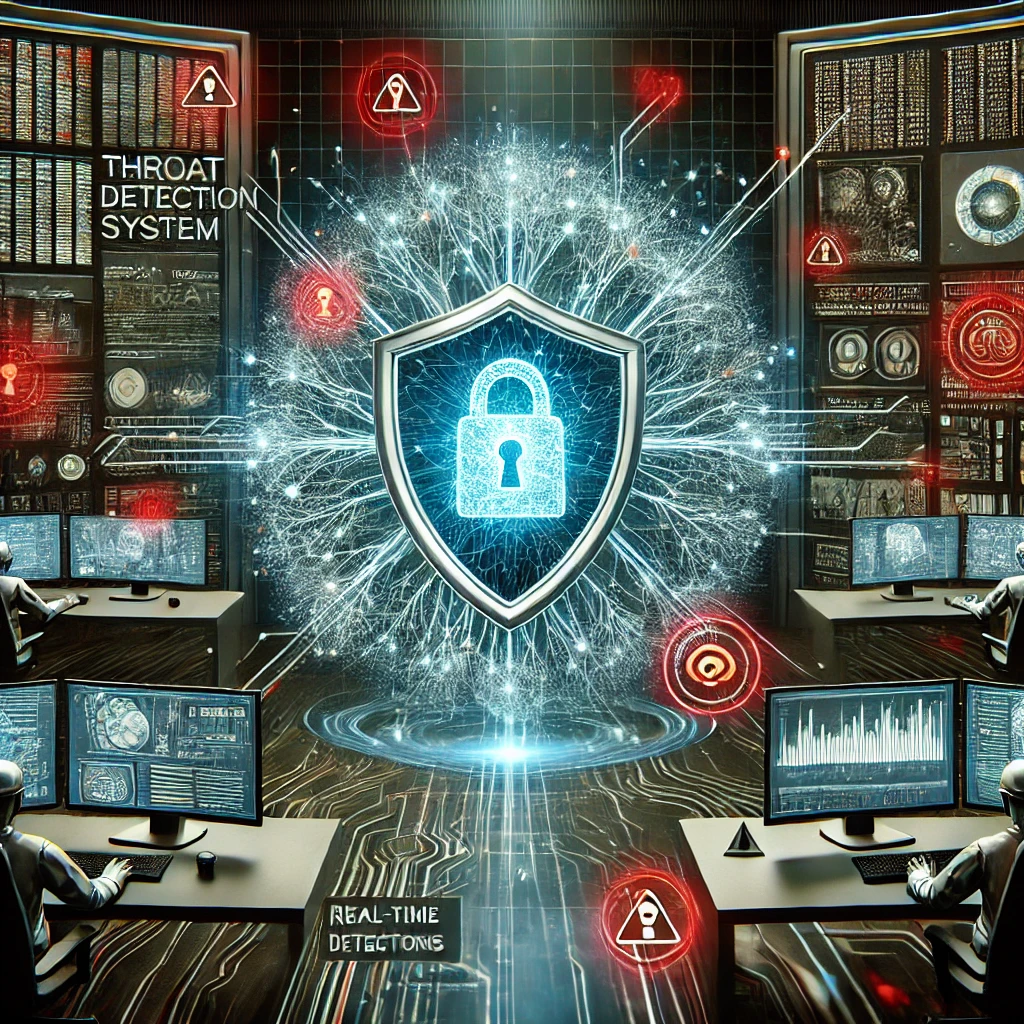AI-Powered Threat Detection and the digital realm, while offering unparalleled opportunities, presents a constantly evolving threat landscape. Cyberattacks are becoming increasingly sophisticated, often bypassing traditional security measures. Artificial intelligence (AI) is emerging as a critical tool in bolstering cybersecurity, offering advanced threat detection capabilities that can identify and mitigate risks in real-time. This article explores the transformative role of AI in reshaping the future of cybersecurity.
The Evolving Cybersecurity Landscape
The sheer volume of data traversing networks today makes manual threat detection nearly impossible. Traditional security solutions, relying on signature-based detection, struggle to keep pace with the rapid emergence of new malware and attack vectors. Cybercriminals are leveraging advanced techniques like polymorphic malware, which constantly changes its code to evade detection, and zero-day exploits, targeting vulnerabilities unknown to software developers. This constant evolution demands a more proactive and intelligent approach to security. The increasing reliance on cloud computing and the Internet of Things (IoT) further expands the attack surface, creating new vulnerabilities for malicious actors to exploit. These interconnected ecosystems require sophisticated security measures capable of analyzing vast amounts of data and identifying anomalous behavior across diverse platforms.
The Rise
The rise of ransomware attacks, where data is encrypted and held hostage, poses a significant threat to businesses and individuals alike. These attacks can cripple operations, resulting in substantial financial losses and reputational damage. Furthermore, the increasing sophistication of phishing campaigns, often employing social engineering tactics, makes it harder for users to distinguish legitimate communications from malicious ones. These targeted attacks can compromise sensitive data and grant attackers access to critical systems.
The skills gap in cybersecurity further exacerbates the challenge. Organizations are struggling to find and retain skilled security professionals capable of managing and responding to the evolving threat landscape. This shortage of expertise leaves organizations vulnerable and highlights the need for automated security solutions that can augment human capabilities. The increasing complexity of cybersecurity threats necessitates a shift towards proactive and intelligent defense mechanisms, capable of anticipating and mitigating risks before they can cause significant damage.
The interconnected nature of modern digital infrastructure means that a breach in one system can have cascading effects across entire networks. This interconnectedness underscores the need for comprehensive security strategies that address vulnerabilities across all endpoints, from individual devices to cloud servers. As the threat landscape continues to evolve, organizations must embrace advanced technologies like AI to strengthen their defenses and stay ahead of emerging threats.
AI’s Role in Threat Detection
AI algorithms excel at analyzing vast datasets, identifying patterns and anomalies that would be impossible for humans to detect manually. Machine learning models can be trained on historical attack data, learning to recognize the subtle indicators of malicious activity. This allows AI-powered systems to identify and flag suspicious behavior in real-time, providing early warning of potential threats. By automating the analysis of security logs, network traffic, and endpoint behavior, AI can significantly reduce the time it takes to detect and respond to cyberattacks.
Threat Detection
AI-driven threat detection systems can identify both known and unknown threats. While traditional signature-based systems can only detect known malware, AI can identify anomalous behavior that may indicate a new or evolving threat. This proactive approach allows organizations to detect and mitigate zero-day exploits and other advanced attacks that bypass traditional security measures. By continuously learning and adapting to new attack patterns, AI-powered systems can stay ahead of the curve in the ongoing cybersecurity arms race.
AI can also enhance the accuracy of threat detection by reducing false positives. Traditional security systems often generate a high volume of alerts, many of which are benign. This can overwhelm security teams and make it difficult to identify genuine threats. AI algorithms can be trained to distinguish between legitimate and malicious activity, significantly reducing the number of false positives and allowing security teams to focus on real threats. This improved accuracy streamlines the incident response process and allows for more efficient resource allocation.
The ability of AI to analyze data from multiple sources provides a more holistic view of the threat landscape. By correlating data from network devices, endpoints, and cloud services, AI can identify patterns and connections that might be missed by traditional security systems. This comprehensive approach allows for more accurate threat detection and enables security teams to understand the full scope of an attack, facilitating a more effective response. The integration of various data sources empowers AI to provide a more complete and accurate picture of the security posture of an organization.
Enhancing Security with AI Power
AI can automate security tasks, freeing up human analysts to focus on more strategic initiatives. Tasks such as vulnerability scanning, malware analysis, and incident response can be automated or augmented by AI, improving efficiency and reducing the workload on security teams. This automation allows organizations to better utilize their limited cybersecurity resources and focus on proactive security measures. By automating routine tasks, AI empowers security professionals to dedicate their time and expertise to more complex and strategic challenges.
AI can personalize security measures based on individual user behavior and risk profiles. By analyzing user activity, AI can identify deviations from normal patterns that may indicate a compromised account or insider threat. This personalized approach allows for more targeted security measures, reducing the risk of insider threats and unauthorized access. Tailoring security protocols to individual users enhances overall security posture and minimizes the impact of potential breaches.
SIEM
AI-powered security information and event management (SIEM) systems can correlate data from various sources to provide a comprehensive view of security events.
This allows security teams to identify and respond to threats more effectively. By integrating AI into SIEM systems, organizations can gain deeper insights into their security posture and improve their ability to detect and mitigate advanced threats.
The enhanced analytical capabilities of AI-powered SIEM systems provide a more proactive and efficient approach to security management.
AI can be used to strengthen endpoint security by detecting and preventing malware infections on individual devices. AI-powered endpoint detection and response (EDR) solutions can identify malicious behavior on endpoints, even if the malware has bypassed traditional antivirus software.
This provides an additional layer of protection against advanced threats and helps to contain the spread of infections. By bolstering endpoint security, AI contributes to a more robust and resilient overall security posture.
Future of AI-Driven Cybersecurity
The future of cybersecurity will be increasingly reliant on AI. As cyberattacks become more sophisticated, AI will play a crucial role in detecting and mitigating threats.
The development of more advanced AI algorithms and the integration of AI into existing security solutions will further enhance the effectiveness of AI-driven cybersecurity.
Continuous innovation in AI will drive the development of more sophisticated and proactive security solutions.
Threat Platforms
AI-powered threat intelligence platforms will enable organizations to share threat information and collaborate on security research. This collaborative approach will improve the overall security posture of the industry by allowing organizations to learn from each other and proactively address emerging threats.
Sharing threat intelligence through AI-powered platforms will foster a more collaborative and effective approach to cybersecurity.
The integration of AI with other emerging technologies, such as blockchain and quantum computing, will create new opportunities for enhancing cybersecurity.
Blockchain can be used to secure data and ensure its integrity, while quantum computing can be used to develop more powerful encryption algorithms.
The convergence of these technologies with AI will revolutionize the field of cybersecurity. These synergistic combinations will unlock new possibilities for securing digital assets and infrastructure.
Privacy Concerns
The increasing use of AI in cybersecurity will also raise new ethical and privacy concerns. It will be important to ensure that AI-powered security systems are used responsibly and ethically, and that they do not infringe on individual privacy rights.
Addressing these ethical and privacy considerations will be crucial for the responsible development and deployment of AI in cybersecurity. Striking a balance between security and privacy will be a key challenge for the future of AI-driven cybersecurity.
AI is transforming the cybersecurity landscape, providing organizations with the tools they need to combat the evolving threat landscape. By leveraging the power of AI, organizations can enhance their security posture, detect and mitigate threats more effectively, and stay ahead of emerging risks.
The future of cybersecurity is undoubtedly intertwined with the continued advancement and integration of AI, promising a more secure digital future.






